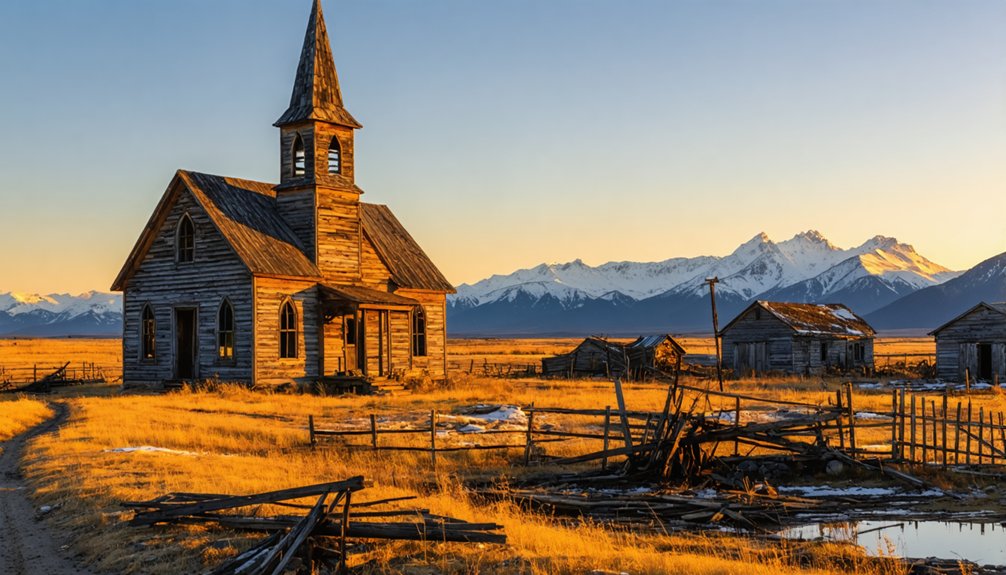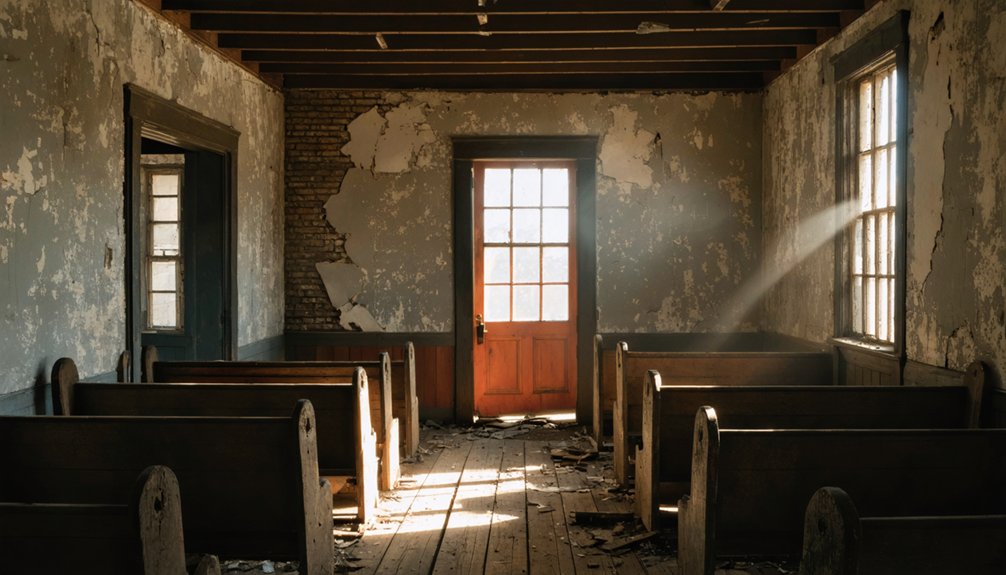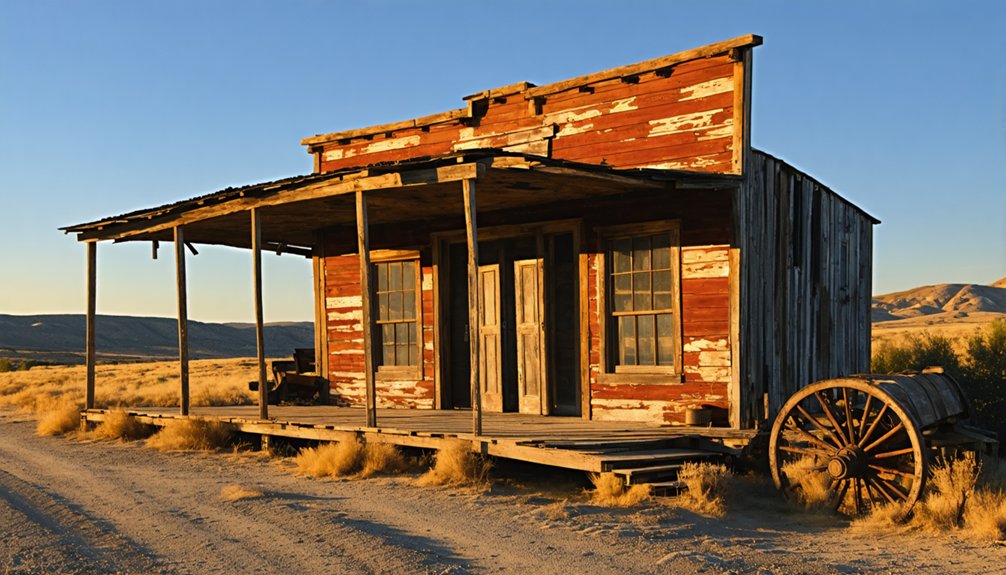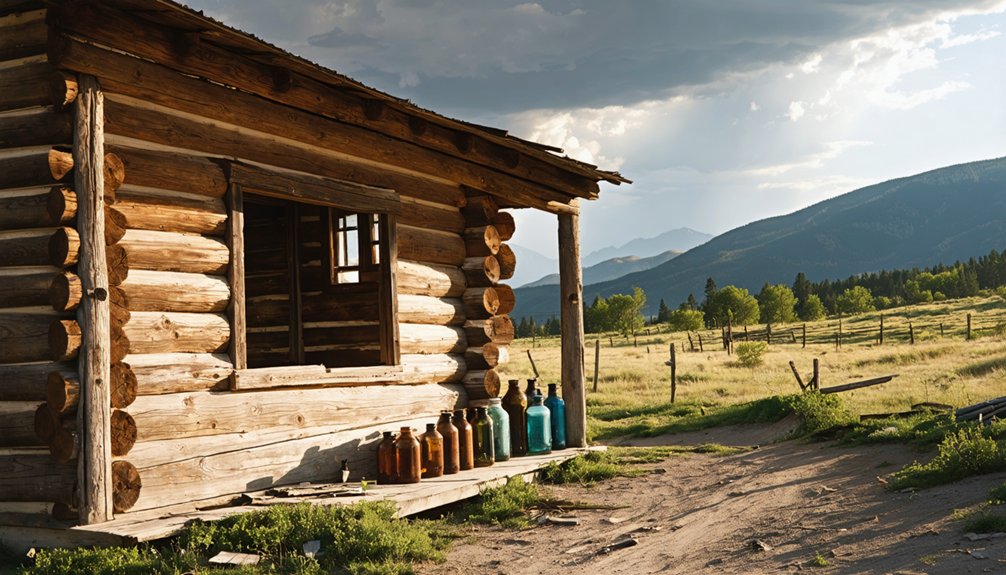You’ll find Fairview’s haunting ruins in Idaho’s Owyhee Mountains, where this silver mining boomtown thrived during the 1860s. The settlement processed 200 tons of ore daily at its peak, with prominent mines like the Orofino and Golden Chariot driving its economy. A devastating fire in 1875, coupled with the Bank of California’s collapse, led to the town’s abandonment. Today, weathered structures and a 41-grave union cemetery tell tales of frontier resilience.
Key Takeaways
- Fairview was a thriving 1860s mining camp in Owyhee County, Idaho, known for gold and silver deposits from War Eagle Mountain.
- The settlement processed 200 tons of ore daily at its peak through operations like Orofino, Mahogany, and Poorman mines.
- A devastating fire in 1875, combined with the Bank of California’s collapse, led to Fairview’s abandonment and ghost town status.
- The ghost town’s ruins and 41-grave union cemetery remain preserved due to Idaho’s arid climate.
- Mining operations were seasonal, running July through September, with hastily built structures adapting to harsh frontier conditions.
The Tale of Two Fairviews: Distinct Idaho Settlements
While Idaho boasts several settlements named Fairview, two distinct communities stand out in the state’s history: one in Franklin County’s Cache Valley and another in the rugged Owyhee Mountains.
You’ll find striking settlement contrasts between these namesake towns. Franklin County’s Fairview emerged as a Mormon agricultural settlement, where families built permanent homes, churches, and schools in the temperate valley. The town earned its name for its views of Logan Temple and the surrounding countryside. Before its decline, Owyhee County’s Fairview was home to over 100 buildings that supported the area’s mining operations.
Over 200 miles away, Owyhee County’s Fairview sprang up as a mining camp in the 1860s, attracting fortune-seekers to the harsh mountain terrain. The cultural differences couldn’t be starker – one community centered around LDS religious life and farming, while the other revolved around mining operations and saloons.
In 1860s Idaho, two Fairviews told contrasting tales: one of Mormon farmers in peaceful valleys, another of rough miners seeking fortune.
Today, Franklin’s Fairview remains an enduring rural community, but Owyhee’s version stands as a ghost town, with only ruins marking its once-bustling existence.
Mining Roots and Early Development
Because War Eagle Mountain held promising gold and silver deposits, Fairview emerged in Owyhee County during the 1860s as a bustling mining settlement.
You’d find several prominent mines here, including the Orofino, Mahogany, Poorman, Golden Chariot, and Ida Elmore, each contributing to the town’s rapid growth.
Mining techniques focused on extracting ore from deep shafts, with operations running mainly from July through September due to harsh mountain conditions.
The town’s economic sustainability relied heavily on California investment capital, particularly through stock sales.
Similar to Silver City’s rich heritage, the area became a significant contributor to Idaho’s mining story.
The town processed an impressive 200 tons of ore daily through its Nevada Hills operation.
You’ll notice this dependence proved fatal when the Bank of California collapsed in 1875, bringing mining operations to a halt.
The town’s infrastructure, which had grown to include over 100 buildings, a miners’ union cemetery, and various mining facilities, largely vanished after a devastating fire in October 1875.
Pioneer Life and Community Spirit

Despite its short-lived existence, Fairview embodied the raw, untamed spirit of Idaho’s mining frontier through its deeply transient community of prospectors, laborers, and merchants.
Fairview’s fleeting frontier tale echoes in the footsteps of miners and merchants who carved life from Idaho’s rugged wilderness.
You’d have found no traditional village life here – instead, the settlement’s pioneer resilience showed in its hastily built structures and the determination to rebuild after devastating fires and financial panics.
In the face of communal struggles, you would’ve witnessed a stark existence centered around mining camps and saloons, much like the atmosphere that drew thousands to Idaho City’s gold discovery in 1862.
While lacking formal institutions like schools or churches, the miners created their own sense of community through informal gatherings and the establishment of a workers’ union cemetery.
Their adaptability to harsh conditions – from brutal winters to unreliable supply lines – reflects the grit required to survive in this unforgiving mountain outpost.
The arid climate helped preserve many of the original structures, allowing modern visitors to glimpse authentic remnants of frontier life.
The Great Fire of 1875 and Its Aftermath
As flames engulfed Fairview in October 1875, the mining town’s wooden structures succumbed to a devastating fire that would reshape its future.
The fire’s origins remain shrouded in mystery, though whispers of arson circulated amid ongoing labor unrest at local mines. You’ll find no documented ignition source, unlike similar fires in other Western mining towns. Like the Idaho City fire of 1865, the destruction caused massive property losses and left many residents homeless. Strong westerly winds spread the flames rapidly through the settlement.
The blaze consumed most of Fairview, leaving its residents to face immediate challenges of shelter and survival.
While reconstruction efforts surely followed, you won’t find detailed accounts of the recovery process in historical records.
The fire’s timing, coinciding with miners’ revolts, dealt a double blow to the community’s economic stability.
Today, this catastrophic event stands as a pivotal moment in Fairview’s transformation from a bustling mining town to an Idaho ghost town.
Water Systems and Essential Infrastructure
You’ll find Fairview’s early water infrastructure relied heavily on open wells and springs until 1914, when the newly incorporated village established its first pipeline from Cherry Creek.
During the changeover period, steam-powered trenching machines worked alongside manual laborers to install the gravity-fed system that would serve the growing community. The Cub River Irrigation Company played a crucial role in managing water resources for local farmers.
The water management eventually shifted from village control to the Fairview Water District in 1953, though the system’s current status remains undocumented as the town stands abandoned.
Early Well Systems Evolution
During the initial settlement of Fairview in 1864, residents relied heavily on a network of open wells and natural springs for their daily water needs.
You’d have found early water management systems consisting of manual collection methods and basic transportation techniques, which served both household and agricultural purposes.
As the mining community grew, you would’ve witnessed the evolution of these primitive systems into more sophisticated arrangements. Similar to the Bureau of Reclamation’s plan in American Falls, these improvements were designed to address water management challenges.
The Lewiston Bear Lake Company’s pumping plant marked a significant advancement in historical irrigation practices, transforming how water reached local farms.
Strategic spring acquisitions expanded the water supply, while the construction of a substantial reservoir enhanced storage capacity.
These improvements proved essential for supporting Fairview’s thriving agricultural sector and growing population, demonstrating the community’s resourceful approach to water infrastructure development.
Pipeline Development 1914
When Fairview’s community leaders gathered in 1914, they made a pivotal decision to modernize the town’s water infrastructure by changing from open wells to an extensive pipeline system.
To tackle pipeline financing, they formed a corporation and borrowed the necessary funds. The project sourced water from Cherry Creek east of Franklin, using innovative trenching techniques that combined steam engine power with manual labor.
- Steam-powered machinery and manual workers with picks and shovels carved out the pipeline routes, showcasing early 20th-century engineering ingenuity.
- The system expanded to include a spring near Preston and later added a large reservoir at Mapleton.
This infrastructure revolution doubled Fairview’s population over the next three decades and transformed the community’s water access until its eventual dissolution in 1953.
Water District Management Changes
The evolution of water district management in Fairview brought significant administrative changes, starting with the establishment of Water District 01 (formerly District 36) in 1919 to oversee Snake River water rights.
You’d have seen a dramatic shift from manual record-keeping to computerized accounting in 1977, revolutionizing how water resources were tracked and allocated.
The district’s scope grew impressively, managing over 345 diversions and 1,142 water rights, while handling more than 122,000 cubic feet per second of diversion rates.
Despite these advances, infrastructure challenges persisted. Records show Fairview Water District faced compliance issues, often struggling with aging systems and documentation requirements.
The shift to modern programming languages like C#.NET enhanced system flexibility, though maintaining regulatory standards remained an ongoing challenge for the district’s operations.
Religious and Social Gathering Places

Given the available historical records, you won’t find evidence of formal religious buildings or dedicated social gathering spaces in Fairview’s early years.
While the mainly Mormon settlers maintained their faith, religious activities likely occurred in private homes rather than in established church structures.
The settlement’s social life centered on informal family gatherings and work-related activities, mirroring the pattern of other small Mormon pioneer communities in late 19th-century Idaho.
Community Rock Church
Standing as a proof of pioneer craftsmanship, Fairview’s rock church emerged from locally quarried stone, including materials sourced from Franklin’s old temple quarry.
With walls three to four feet thick, this architectural heritage provided natural insulation while showcasing the community’s dedication to lasting construction. Until its demolition in 1926, you’d find this building at the heart of Fairview’s community significance, hosting everything from religious services to celebrations.
- You could attend weddings, dances, and ward reunions within its sturdy stone walls
- The church’s multi-purpose design reflected pioneer practicality and resourcefulness
- Local stone craftsmanship demonstrated the builders’ skill in creating lasting structures
Like other Mormon rock churches of its era, Fairview’s church served as more than just a religious center—it was your community’s cultural cornerstone.
Mormon Social Activities
As Mormon pioneers established themselves in Fairview and other Idaho settlements, social activities became the lifeblood of their close-knit community.
You’d find families gathering regularly for ball games, horse races, and holiday celebrations that reinforced their Mormon traditions. During warm months, they’d meet at outdoor bowerys, while schoolhouses and church buildings served as winter venues for dances and socials.
Community events were carefully organized by local leaders, featuring everything from quilting parties to Fourth of July festivities.
The Twenty-fourth of July held special significance, drawing families together for celebrations that strengthened their cultural bonds.
These gatherings weren’t just social occasions – they created a support network where community members could rely on each other, fostering the resilient spirit that defined Mormon settlements throughout Idaho.
Dance and Church Functions
While mining activity fueled Fairview’s economic growth, the town’s social fabric centered around its churches and dance halls.
You’ll find that dance traditions thrived at venues like the Cafferty Dance Hall, which operated from 1917 to 1936, bringing the community together for regular celebrations. The Rock Church, with its sturdy stone walls, served as both a religious sanctuary and social hub, hosting church celebrations throughout the year until its demolition in the late 1920s.
- The Fairview Mercantile Company and public square provided additional spaces for community gatherings
- Local residents actively organized and participated in both religious and social events
- Church functions often doubled as cultural exchange opportunities among townspeople
These social spaces helped forge a strong sense of community identity that persisted until mining operations declined.
From Boom to Abandonment

Despite its promising start as a bustling mining settlement, Fairview’s prosperity proved short-lived when two catastrophic events in 1875 sealed its fate.
Fortune is fickle – Fairview’s dreams of mining wealth vanished in 1875 when twin disasters struck this Idaho boomtown.
In October, a devastating fire ripped through the town, destroying most of its 100-200 buildings. Shortly after, the Bank of California’s collapse cut off essential funding for War Eagle Mountain’s mines, forcing them to close.
You’ll find that Fairview’s mining economy crumbled quickly after these twin disasters. Miners and their families abandoned the settlement, seeking opportunities elsewhere.
What was once a thriving community with a strong miners union, post office, and cemetery became just another Idaho ghost town.
Today, only a few deteriorating structures and the old union cemetery with its 41 graves remain as silent witnesses to Fairview’s brief but vibrant existence.
Preserving Idaho’s Mining Heritage
Today, preserving Idaho’s rich mining heritage stands as a critical mission that extends far beyond simple historical conservation. You’ll find dedicated organizations like the Idaho Heritage Trust working tirelessly to protect historic sites through mining preservation efforts that safeguard structures, trestles, and tramways for future generations.
- Experience authentic mining history through stabilized structures and carefully preserved artifacts
- Support community-driven restoration projects that keep Idaho’s mining story alive
- Discover heritage education programs that reveal the environmental and cultural impacts of mining
Through partnerships with federal agencies and local communities, these preservation efforts guarantee that sites like Fairview remain powerful testimonials to Idaho’s mining era.
Your involvement in these initiatives helps maintain the delicate balance between protecting historical treasures and promoting responsible stewardship of these remarkable places.
Frequently Asked Questions
What Wildlife and Natural Hazards Did Early Fairview Settlers Encounter?
You’d face fierce wildlife encounters with bears, wolves, and mountain lions, while natural hazards like harsh winters, summer lightning fires, and flooding from snowmelt tested your survival skills.
Are There Any Documented Paranormal Activities in Fairview’s Ghost Town Ruins?
You won’t find official records of ghost sightings or paranormal investigations at these ruins. While mining ghost towns often spark supernatural tales, there’s no documented evidence of paranormal activity in these remains.
What Happened to the Mining Equipment After the Towns Were Abandoned?
You’ll find the mining machinery fate was quite melancholic – equipment deteriorated from harsh weather, while some pieces were scavenged for parts. Today, only traces remain, with minimal abandoned equipment restoration efforts.
How Did Native American Tribes Interact With Fairview’s Early Settlers?
You’ll find early tribal relations were largely peaceful, with Native Americans and settlers engaging in trade and cultural exchanges until the 1860s, when resource competition sparked growing tensions and displacement.
Which Original Artifacts From Fairview Can Be Found in Idaho Museums?
You’ll find authentic Fairview artifacts in Idaho museums, including mining tools, ore carts, crockery shards, farm equipment, pioneer photographs, and town signage at Lawson’s Legacy Museum and the Idaho State Historical Society.
References
- http://www.franklincountyhist.org/communities.html
- https://visitidaho.org/things-to-do/ghost-towns-mining-history/
- https://mix106radio.com/idahos-creepiest-ghost-towns/
- http://www.franklincountyhist.org/fairview.html
- https://www.ghosttowns.com/states/id/fairview.html
- https://en.wikipedia.org/wiki/Fairview
- https://westernmininghistory.com/towns/idaho/fairview/
- https://nvtami.com/2025/05/19/fariview-ghost-town/
- https://www.youtube.com/watch?v=rTSZSlxTmbs
- https://www.youtube.com/watch?v=6GwcoAryV3M



